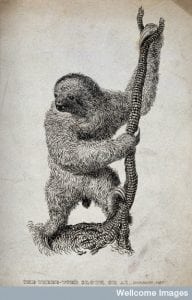The wind has been wildly whipping the last few days, putting me on edge. It doesn’t help that the wind makes the neighbourhood noisier than usual: clanking gates, blowing cans… The normally distant rumble of the tube train suddenly passes right down our street, while the planes seem to fly right over our roof. The weather can do funny things to sound.

Tableau of William Derham (1657 – 1735), an English clergyman and natural philosopher. Source: Wikimedia Commons, uploaded by Palthrow.
Back in 1708, William Derham was inspired by his observations on weather and sound to publish on the motion of sound in the Philosophical Transactions. Derham’s letters to Sloane show how Derham had carefully thought about the subject for years before his article appeared. Academic writers will have much sympathy for Derham’s path toward publication.
In January 1704/5, Derham was confident that he was “setteling the business of the Flight of Sounds, which may be of good use”. He had ten questions and was happy to add more if anyone in the Royal Society had any; by the time he published, there were nineteen questions. Derham was charting the sound of gunfire to determine what factors affected sound, such as the type of winds and weather, size of gun, time of day, and direction of the shot.
Many credible authorities, from the Florentine Academy to Isaac Newton, had differed on the question of “What Space Sounds fly in a Second or any determinate Time?” To settle the matter, Derham repeated their experiments and at greater distances. The answer seemed close:
I have allmost satisfied my self about all the former Enquiries, which when I have fully done I will impart it to the Society. I only want a few Guns from the Tower or some such large distance (which I could see in the Evening) to fully confirm what I have already done.
Derham was more guarded by April 1705. He reported that he was not as close to finishing his experiments as he’d hoped. Having met “with fresh matters” that nobody had ever observed before, he was “cautious of determining any thing precipitatly; & therefore I shall yet delay giving the Society an account of what I have done”.

A light-hearted picture, but I hasten to add that Derham did not use women’s skirts to test his theories on sound. Lithograph by C.H. Bacle, 19th century. Credit: Wellcome Library, London.
What he could tell them was that “Storms do accelerate Sounds, wch I did not discover (only suspect) till last Fryday” when he had been timing the sound of guns fired at Blackheath. Contrary winds resulted in delays, while high winds sped the sounds up. But to test his theory, he needed more guns. Derham reassured Sloane that he would “use my greatest care in all this matter” because his newest observations differed so greatly from those of others–and “perhaps the Societys reputation my be somewhat hurt by any neglect or want of an act”.
In December 1706, Derham was still working on the project. He had only just found “an excellent semi-circle to take the Angles, & thereby the distances of the places from whence I observed the Flight of Sounds”. This, he noted, “was the only thing that hath delayed the me from imparting my Observations on that subject.” And in April 1707, he referred in passing to using triangulation to measure sound.
Finally, Derham sent off his observations in February 1707/8. His letter hints at his relief, as well as his hope that the article would be published as soon as possible.
I have sent you my Observations about Sounds; which as it hath cost me some pains, so I hope will be acceptable to you, & the most illustrious Society. If you think it worth publishing in the Transactions, I desire you will be pleased to put it into one of the next.
A week later, Derham’s anxiety emerges more clearly when he wondered whether Sloane had even received the article: “Be pleased to let me know whether you recd my account of Sounds with my Packet of Lrs from Florence.”
The article was intended to be Derham’s Important Work (and it was), appearing as it did in Latin rather than the English he usually used for his Phil. Trans. submissions. It also took up a full thirty-three pages. With his careful measurements, increased distances, and use of instruments, Derham provided a more accurate assessment of the speed of sound than previous scholars.
It’s just a shame that Derham never mentioned his mysterious Japanese (?) co-author anywhere in his letters to Sloane…
According to a data entry howler error in the online Phil. Trans., Soni Motu was the first author on the article. How’s that for revisioning history?












![The Hospital of Bethlem [Bedlam] at Moorfields, London: seen from the south, with three people in the foreground. Etching by J. T. Smith after himself, 1814. Image Credit: Wellcome Library, London.](http://sloaneletters.com/wp-content/uploads/2014/06/Bedlam-at-Moorfields-1814-229x300.jpg)
![Statues of "raving" and "melancholy" madness, each reclining on one half of a broken segmental pediment, formerly crowning the gates at Bethlem [Bedlam] Hospital. Engraving by C. Warren, 1808, after C. Cibber, 1680. Image Credit: Wellcome Library, London.](http://sloaneletters.com/wp-content/uploads/2014/06/Figures-in-front-of-Bedlam-300x210.jpg)







